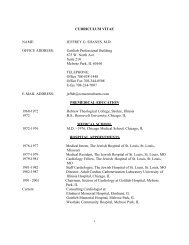Triglycerides: A useful definition
Triglycerides: A useful definition
Triglycerides: A useful definition
Create successful ePaper yourself
Turn your PDF publications into a flip-book with our unique Google optimized e-Paper software.
which are subsequently moved to absorptive enterocytes, cells lining the intestines. The<br />
triglycerides are rebuilt in the enterocytes from their fragments and packaged together<br />
with cholesterol and proteins to form chylomicrons. These are excreted from the cells and<br />
collected by the lymph system and transported to the large vessels near the heart before<br />
being mixed into the blood. Various tissues can capture the chylomicrons, releasing the<br />
triglycerides to be used as a source of energy. Fat and liver cells can synthesize and store<br />
triglycerides. When the body requires fatty acids as an energy source, the hormone<br />
glucagon signals the breakdown of the triglycerides by hormone-sensitive lipase to<br />
release free fatty acids. As the brain cannot utilize fatty acids as an energy source (unless<br />
converted to a ketone), the glycerol component of triglycerides can be converted into<br />
glucose, via glycolysis by conversion into Dihydroxyacetone phosphate and then into<br />
Glyceraldehyde 3-phosphate, for brain fuel when it is broken down. Fat cells may also be<br />
broken down for that reason, if the brain's needs ever outweigh the body's.<br />
<strong>Triglycerides</strong> cannot pass through cell membranes freely. Special enzymes on the walls<br />
of blood vessels called lipoprotein lipases must break down triglycerides into free fatty<br />
acids and glycerol. Fatty acids can then be taken up by cells via the fatty acid transporter<br />
(FAT).



